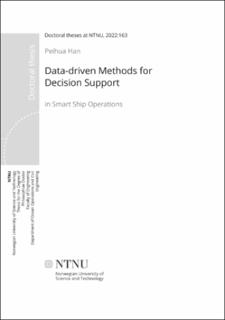| dc.contributor.advisor | Zhang, Hoxiang | |
| dc.contributor.advisor | Li, Guoyuan | |
| dc.contributor.author | Han, Peihua | |
| dc.date.accessioned | 2022-06-23T07:08:53Z | |
| dc.date.available | 2022-06-23T07:08:53Z | |
| dc.date.issued | 2022 | |
| dc.identifier.isbn | 978-82-326-6301-9 | |
| dc.identifier.issn | 2703-8084 | |
| dc.identifier.uri | https://hdl.handle.net/11250/3000166 | |
| dc.description.abstract | Vessels operating on the surface of the ocean today are now increasingly equipped with sensors. This includes GPS, MRU, IMU that monitor the vessel’s motion behavior, and power, RPM, temperature sensors that monitor the status of components such as engines and thrusters, and anemometers that provide information about the surrounding environment. These sensor measurements are obtained in real-time and historical data is saved in cloud storage. The increased digital capabilities motivate the industry to increase the automation of the vessel by developing decision support systems, digital twin, or autonomous ships, which might potentially lead to safer and more efficient ship operations.
How to use the massive data on ships to gain better insight into ship operations has always been a key issue, and the data-driven approach is a promising solution. Datadriven methods, or machine learning methods, have been used broadly across a range of industries concerned with data-intensive issues. As the ship is gradually turned into a colossal sensor hub, the massive volume of data can be used with supervised learning to generate models to support efficient ship operations, or unsupervised learning to provide key insights about ships.
To provide information to the human ship operator or autonomous ship operating system, two aspects can be identified: (1) a better understanding of the current status, such as component’s status, environmental conditions, or operating conditions. (2) a better forecast on what will happen if a specific action is taken, which can be referred to as what-if analysis. In such a context, many elements can be involved (localization, trajectory prediction, etc.). In this dissertation, two important applications are highlighted: fault diagnostics and prognostics of components, and the estimation of the sea state.
Fault diagnostics and prognostics aim to detect and isolate faults on components or systems, and then predict how the fault will progress and how long it will be until complete failure. Through these actions, recommendations for maintenance can be provided. In other words, an ideal maintenance schedule can be devised and failure can be eliminated. In this way, the vessel can operate safely and efficiently. The sea state information is of key importance for ship operations, such as motion control, pipeline laying, and path planning. Wave radar may be an ideal solution for obtaining information about surrounding waves, but most ships today do not equip with one. However, it is also possible to estimate the sea state from the vessel motion responses (especially motions that are not affected by the controller: roll, pitch, heave, etc.). Thus another focus of this dissertation is to develop sea state estimation models that use ship motion responses as inputs. Since both fault diagnostics and prognostics and sea state estimation can be achieved with machine learning, the main objective is to develop data-driven models for these two applications. Three case studies are conducted to validate the dei veloped data-driven models for these two applications, where the first two concerns fault diagnostics and prognostics (use thruster and engine as an example, respectively), the last one concerns sea state estimation. Experiments are carried out with data collected in simulations, in the laboratory, and on the vessel RV Gunnerus operating in the real world. The results demonstrate the advantages of developing data-driven models to support ship operations. Additionally, data-driven models can outperform traditional models in certain scenarios. | en_US |
| dc.language.iso | eng | en_US |
| dc.publisher | NTNU | en_US |
| dc.relation.ispartofseries | Doctoral theses at NTNU;2022:163 | |
| dc.relation.haspart | Paper 1: Han, Peihua; Li, Guoyuan; Skulstad, Robert; Skjong, Stian; Zhang, Houxiang. A Deep Learning Approach to Detect and Isolate Thruster Failures for Dynamically Positioned Vessels Using Motion Data. IEEE Transactions on Instrumentation and Measurement 2021 ;Volum 70. https://doi.org/10.1109/TIM.2020.3016413 | en_US |
| dc.relation.haspart | Paper 2: Han, Peihua; Li, Guoyuan; Skjong, Stian; Wu, Baiheng; Zhang, Houxiang. Data-driven sea state estimation for vessels using multi-domain features from motion responses. I: 2021 IEEE International Conference on Robotics and Automation (ICRA). IEEE 2021 ISBN 978-1-7281-9077-8. s. 2120-2126 https://doi.org/10.1109/ICRA48506.2021.9561261 | en_US |
| dc.relation.haspart | Paper 3: Han, Peihua; Li, Guoyuan; Cheng, Xu; Skjong, Stian; Zhang, Houxiang. An Uncertainty-aware Hybrid Approach for Sea State Estimation Using Ship Motion Respon ses. IEEE Transactions on Industrial Informatics 2022 ;Volum 18.(2) s. 891-900 https://doi.org/10.1109/TII.2021.3073462 | en_US |
| dc.relation.haspart | Paper 4: Han, Peihua; Ellefsen, Andre; Li, Guoyuan; Holmeset, Finn Tore; Zhang, Houxiang. Fault Detection with LSTM-Based Variational Autoencoder for Maritime Components. IEEE Sensors Journal 2021 ;Volum 21.(19) s. 21903-21912 https://doi.org/10.1109/JSEN.2021.3105226 | en_US |
| dc.relation.haspart | Paper 5: Han, Peihua; Ellefsen, Andre; Li, Guoyuan; Æsøy, Vilmar; Zhang, Houxiang. Fault Prognostics Using LSTM Networks: Applicatio n to Marine Diesel Engine. IEEE Sensors Journal 2021 ;Volum 21.(22) s. 25986-25994 https://doi.org/10.1109/JSEN.2021.3119151 | en_US |
| dc.relation.haspart | Paper 6: Han, Peihua; Li, Guoyuan; Skjong, Stian; Zhang, Houxiang. Directional wave spectrum estimation with ship motion responses using adversarial networks. Marine Structures 2022 ;Volum 83. https://doi.org/10.1016/j.marstruc.2022.103159 This is an open access article under the CC BY license | en_US |
| dc.title | Data-driven Methods for Decision Support in Smart Ship Operations | en_US |
| dc.type | Doctoral thesis | en_US |
| dc.subject.nsi | VDP::Technology: 500::Marine technology: 580 | en_US |

